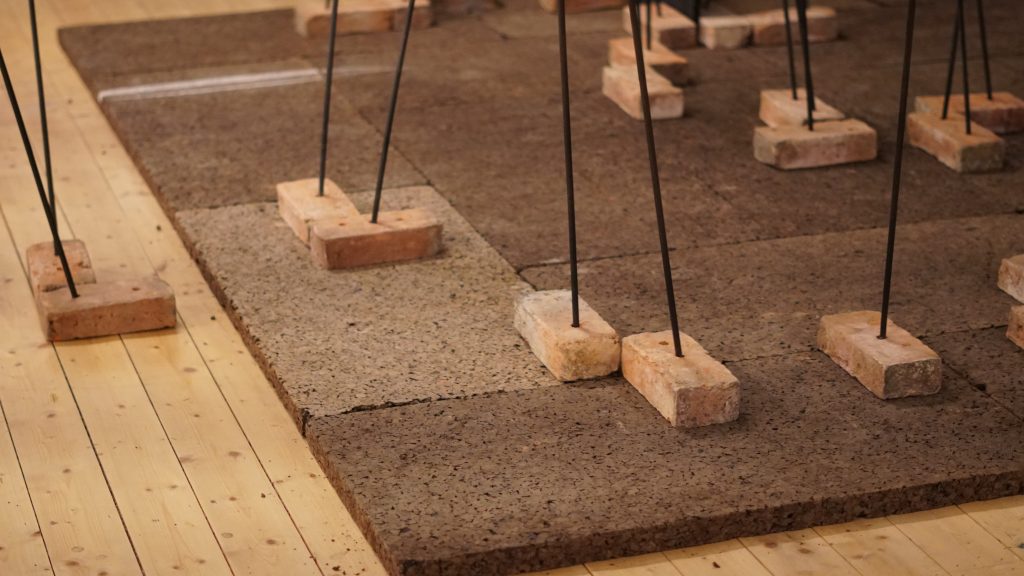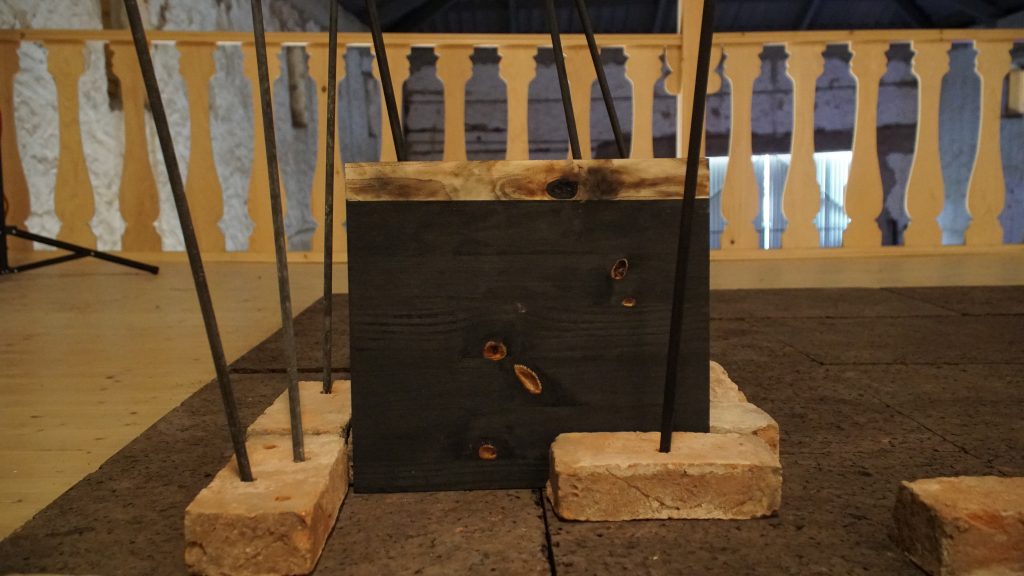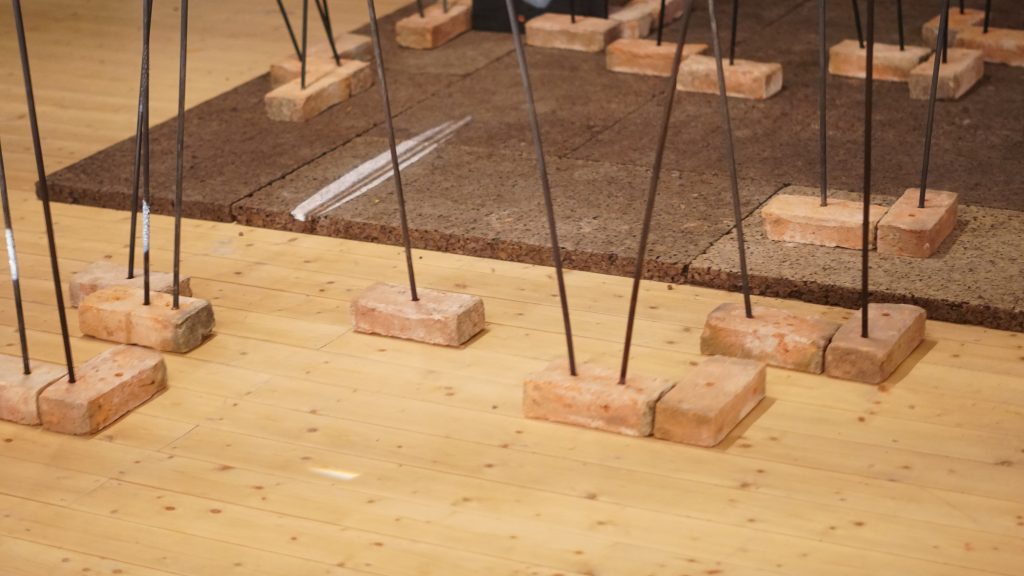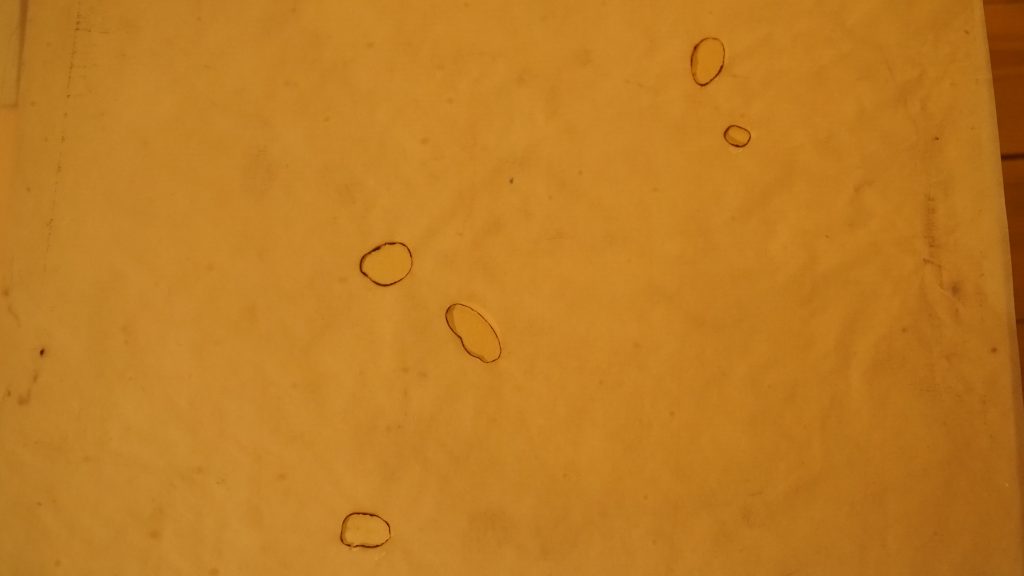Nó no Sol
Mónica Garcia

PT//
“Os homens ouviam as respirações musicais dos pinheiros milhares de anos antes da ciência remover a poesia à natureza (…) Na tradição Germânica, cada sulco ou nó no tronco do pinheiro era um ponto do qual um espírito da madeira se escapava para o mundo exterior.” Skinner, Charles M.
Nó no Sol vai ao encontro do desenho preexistente na madeira do pinheiro procurando-lhe os nós como ponto de partida e chegada para provocar o fenómeno de um pensamento mágico que procura o movimento de crescimento a partir dos mesmos. Perscrutados manualmente com a goiva, no desenho na matriz de madeira, podemos encontrá-los expandidos no espaço como o produto da própria respiração e digestão do fogo que formou a primeira cópia da matriz. O fogo seria o primeiro a ver, seguindo-se o olho como responsável a queimar o espaço, formador da segunda cópia, crescida esta sobre fundo negro. Segundo uma lenda germânica, os espíritos da madeira do pinheiro escapavam pelos seus nós, sendo aqui o corpo espectral da luz o seu fantasma capaz de dilatar o tempo, capaz de servir também como ponte de sustento ao fogo, ativar-lhe o seu corpo ausente assim como acontece com as estrelas desaparecidas que ainda continuamos a ver. Os pinheiros crescem agora sobre fogo ausente através da mão que queima em cima de um jogo de tijolos, retirado de um poço, e procuram esperar pela voz da própria matéria.
EN//
“Men heard the musical breaths of pine trees thousands of years before science removed poetry from nature (…); In the German Tradition, each groove or knot in the pine tree trunk was a point from which a wood’ spirit escaped to the outside world.” Skinner, Charles M.
Nó no Sol (Node in the Sun) meets the pre-existing design in the pine wood by looking for the knots as a starting and ending point to provoke the phenomenon of a magical belief that seeks the movement of growth from them. Persecuted manually with the gouge, in the drawing of the wood pattern, we can find the knots expanded in space as the product of the very breath and digestion of fire that formed the first copy of the matrix. The fire would be the first to see, followed by the eye as responsible for burning the space, forming the second copy, grown on a black background. According to a Germanic legend, the spirits of the pine wood escaped through their knots, through their spectral body of light. Their ghosts would be capable of dilating time, and also to serve as a bridge to sustain the fire, activating its absent body as it happens with the light of missing stars that we still see. Pines now grow on absent fire through the hand burning on top of a game of bricks, taken from a well, and seek to wait for the voice of matter itself.



BIO
PT//
Mónica Garcia (Setúbal, 1989) é licenciada em Artes Plásticas na Escola Superior de Artes e Design das Caldas da Rainha, onde atualmente frequenta o Mestrado. O seu trabalho caracteriza-se por um cunho experimental entre desenho, instalação site-specific e performance, cultivando um pensamento sobre a história do lugar de cariz fenomenológico e pré-científico. Expõe com frequência desde 2011, tendo recebido várias distinções, destacando-se entre outros o prémio de desenho “Pedro de Sousa” em 2016.
EN//
Mónica Garcia (Setúbal,1989) has a degree in Fine Arts from Superior School of Arts and Design of Caldas da Rainha, where she currently is pursuing a Master’s degree. Her work is characterized by an experimental character between drawing, site-specific installation and performance, cultivating a phenomenological and pre-scientific thought about the history of the place. She exhibits frequently since 2011 and she has received several distinctions, among which the “Pedro de Sousa” drawing award, in 2016, stands out.

